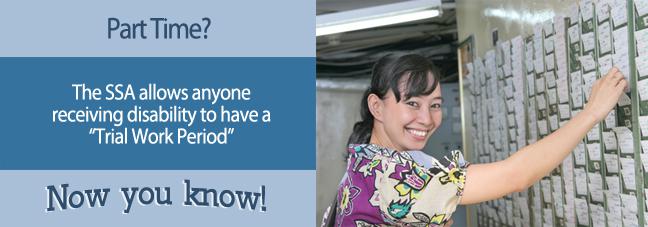The Social Security Administration (SSA) provides monthly disability benefits to applications that are unable to work due to a disabling medical condition. These benefits can help pay for medical expenses and everyday living costs. You may be able to hold a part-time job while still receiving disability benefits, although the amount of wages you earn could affect your situation.
Substantial Gainful Activity
Any work that brings in a set certain amount of income per month is known as substantial gainful activity (SGA). The SSA uses this to determine whether or not you are actually disabled and eligible for benefits, because if you are able to work enough to earn a certain amount of money, you are able enough to work and make competitive income with your condition. For 2025, the income limit for SGA is:
- $1,620 per month if not blind
- $2,700 per month for blind applicants
Even if your income is over or under these substantial gainful activity amounts, the SSA may still want to evaluate your work ability. For instance, you may hold a volunteer job at a soup kitchen that requires fast-paced physical activity, which would let the SSA know that you can work at a restaurant, even if your low income suggests that you need benefits.
On the other hand, you could be making high wages over the income limit, but the job may cater to your disability, which would suggest to the SSA that you actually are qualified for assistance despite your high income. To qualify for disability, you must be completely unable to earn SGA.
SSDI Benefits
Social Security Disability Insurance (SSDI) benefits are paid through income taxes and based on your employment history. They are meant for workers who become disabled before they are able to retire.
For SSDI benefits, the SGA income limit applies after you are approved for benefits and start receiving them. However, you do have a “trial work period” of nine months after you first start receiving your benefits, during which you can work more than the SGA limit allows.
SSI Income Limit
Supplemental Security Income (SSI) benefits are based financial need, not work history. For SSI benefits, there is a different income limit that is based on the federal benefit rate (FBR). The FBR represents both the SSI income limit and the maximum federal monthly SSI payment. For 2025, this amount is:
- $967 for individuals
- $1,450 for a married couple
Note that not all of your wages will be counted towards this limit, so you can theoretically make more than $967 per month. Make sure you know exactly what wages will count towards the income limit and what won’t, so that you don’t go over the limit and get your benefits decreased or denied.
If you participate in a federal program called Plan to Achieve Self Support (PASS), then the SSA allows you to set aside funds to help you transition off of your disability benefit payments, and this money won’t count towards the income limit.
State Supplements
Except for eight states, most states provide additional money towards your SSI payments that go above the federal amount. Depending on the state, this supplement will raise your income limit and maximum monthly payment. Supplements range from $10 to $400 and can depend on your marital status, living arrangement, and other factors.
